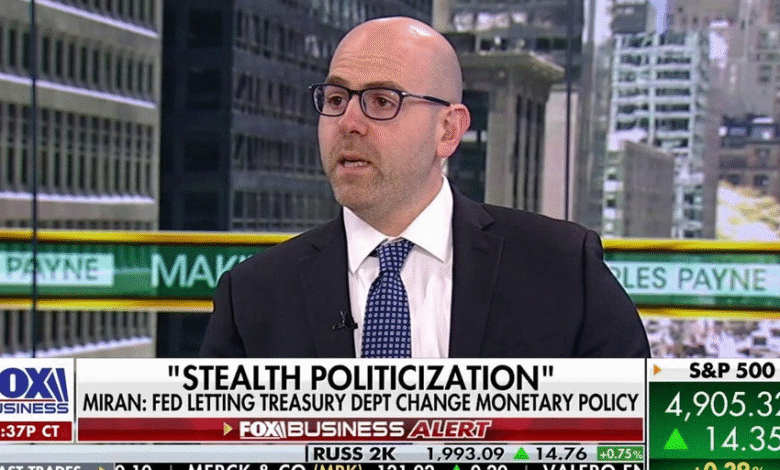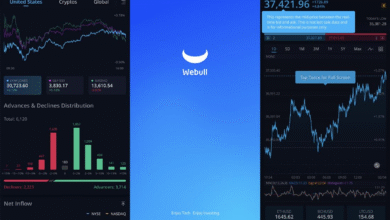Stephen Miran Federal Reserve Appointment by Trump

In a significant move, President Trump has appointed Stephen Miran for a coveted seat on the Federal Reserve, marking a shift in Washington’s economic landscape. Miran, a former senior economic advisor, replaces Adriana Kugler, whose resignation amid rising tensions with the Trump administration has added urgency to the Federal Reserve Board changes. Known for his critical stance towards Fed Chairman Jerome Powell, Miran’s appointment aligns with Trump’s strategy to influence monetary policy amidst ongoing debates about interest rates and inflation. As discussions intensify over the direction of the Federal Reserve, Miran’s economic insights are expected to fortify Trump’s vision for a more favorable fiscal environment. With this new appointment, the Federal Reserve’s dynamics are poised for transformation as Miran and fellow board members advocate for a potential reduction in rates, a move that the President insists is essential for alleviating burdens on the national debt.
In a notable reshuffle in U.S. monetary policy leadership, President Trump has tapped Stephen Miran to fill the recent vacancy on the Federal Reserve Board. This development follows Adriana Kugler’s unexpected resignation, underscoring the ongoing friction between the Federal Reserve and the current administration. Miran, who has served as a prominent economic advisor during Trump’s presidency, is set to bring his expertise to a board that has experienced significant changes and challenges. Known for advocating a more aggressive approach to interest rate cuts, this appointment may signal a pivotal turn in the Fed’s policy decisions, particularly in light of existing tensions with Chair Jerome Powell. As the Federal Reserve navigates this new terrain, Miran’s presence is likely to play a critical role in shaping economic strategies moving forward.
Stephen Miran Federal Reserve Appointment: A New Era
President Trump’s immediate selection of Stephen Miran for the Federal Reserve reflects a strategic move to reshape the central banking landscape. Miran, who previously served as a senior economic policy advisor, embodies the administration’s desires for a more economically aggressive Federal Reserve. His appointment follows the unexpected resignation of Adriana Kugler, signaling a critical shift in the Federal Reserve Board that aligns with Trump’s economic philosophy. This transition may forge a path towards implementing the administration’s monetary policies, particularly in advocating for lower interest rates.
Miran’s background as the Chairman of the Council of Economic Advisors showcases his economic expertise which Trump believes is vital in navigating the complexities of modern fiscal policy. As tensions between the Federal Reserve and the executive branch have escalated, particularly regarding interest rates, Miran’s position promises fresh insights that could align the Fed more closely with the administration’s goals. The appointment aims to revitalize and perhaps recalibrate the Federal Reserve’s policies to address the mounting national debt and economic challenges facing the country.
Impact of Adriana Kugler’s Resignation
The resignation of Adriana Kugler has reverberated through financial circles, signaling potential shifts in Federal Reserve policy. As one of the governors, her departure leaves a notable gap that Stephen Miran is expected to fill, bringing a fresh perspective amidst ongoing challenges. Kugler’s resignation was seen as a response to the escalating tensions between the Trump administration and the largely independent Federal Reserve, particularly regarding monetary policy decisions. This political backdrop has added urgency to the appointment of Miran, who may now influence the direction of interest rate policies.
With Kugler gone, the dynamic within the Federal Reserve Board is likely to change significantly. Miran’s appointment introduces a voice advocating for lower interest rates, which Trump has emphasized as critical to mitigating the impact of the national debt. As the board prepares for upcoming meetings, analysts are watching closely to see how Miran’s presence alters the decision-making process. Will his approach to economic policy signal a departure from past decisions, or will it reaffirm existing paradigms as the Fed grapples with its dual mandate of stable prices and maximum employment?
Jerome Powell’s Relationship with Trump Administration
The ongoing tensions between President Trump and Federal Reserve Chairman Jerome Powell have highlighted a complex relationship fraught with challenges. Trump’s criticism of Powell’s policies represents a broader conflict between the executive branch and the central bank’s autonomy. Critics argue that this discord could undermine trust in the institution’s independence, which is foundational to its credibility. As Miran joins the Fed, many are curious about how his views will align with those of Powell and whether they can collaboratively address the pressing concerns surrounding economic growth.
As Miran steps into his role, the potential for collaborative policy-making with Powell remains uncertain. Historically, the Fed has maintained its independence, often making decisions that might not align with the whims of political leaders. The pressure from the Trump administration for aggressive rate cuts to manage national debt indicates a shift in expectations for Fed leadership. How Miran navigates this tension could define his tenure and the broader approach the Federal Reserve takes in balancing economic stability against political pressures.
The Future of the Federal Reserve Board: Changes Ahead
With Stephen Miran’s appointment and the anticipated changes on the Federal Reserve Board, the future direction of U.S. monetary policy could be significantly altered. The strategic inclusion of board members who align more closely with Trump’s economic vision may lead to a departure from traditional practices. As Miran prepares to influence central bank decisions, the upcoming months may reveal a stronger push for rate reductions, particularly in an effort to respond to the administration’s concerns about the national debt.
There is speculation that if Miran and others advocate successfully for reported interest rate cuts, it could set a precedent for further alterations in the Fed’s approach. A potential overhaul of the board post-Powell’s tenure could solidify this new direction, especially as discussions around economic recovery and inflation rise. The implications of such changes could reverberate throughout the economy, warranting close attention from analysts and policymakers alike.
Navigating Economic Policy: Miran’s Vision for the Fed
As a proponent of change, Stephen Miran’s vision for the Federal Reserve will be critical in shaping economic policies going forward. Having served as a senior economic advisor under Trump, Miran is well-acquainted with the administration’s fiscal goals. His focus on reducing interest rates and managing the national debt reflects a broader ambition to stimulate economic growth through supportive monetary policies. Observers are eager to see how his ideas will come to fruition within the traditionally cautious confines of the Federal Reserve.
Miran’s perspectives on taxation, regulatory policies, and interest rate management could potentially invigorate discussions within the Fed. As the central bank confronts persistent economic challenges, the influence of Miran may herald a new approach that prioritizes aggressive fiscal measures. His academic and practical background in economic policy equips him uniquely to contribute to an evolving narrative of the Fed’s role in the American economy.
The Role of the Federal Reserve in Tackling National Debt
The Federal Reserve’s role in managing the national debt is under fierce scrutiny as the country grapples with a staggering $36.67 trillion financial burden. President Trump’s call for immediate action to cut interest rates highlights the urgency of addressing this issue, and Stephen Miran’s appointment comes at a pivotal time. With the administration keen on decreasing the government’s interest payments, the Fed may face pressure to adopt unconventional monetary policies to mitigate fiscal strain.
The implications of national debt on the economy necessitate a careful balancing act for the Federal Reserve. As Miran joins the board, his ability to influence rate decisions could directly correlate with the government’s fiscal health. Observers will be watching closely as the Fed tries to navigate fiscal responsibility while promoting economic expansion, especially with key meetings approaching where these topics will take center stage.
Examining Trump’s Federal Reserve Picks: A Critical Shift
The Trump administration has strategically selected figures like Stephen Miran to reshape the Federal Reserve Board, reflecting a desire for an economic paradigm shift. By appointing experienced advisors who share the president’s skepticism towards traditional Fed policies, Trump is prioritizing a central bank more aligned with his economic agenda. This history of unconventional appointments, including the recent resignation of Adriana Kugler, illustrates an ongoing effort to fortify his influence over the central bank towards policies that resonate with his ideals.
Miran’s background in economic policy underlines a trend in Trump’s appointments, emphasizing a decisive shift towards individuals who challenge conventional economic orthodoxy. As these federal appointments evolve, analysts are considering how this course corrections may play out in monetary policy discussions. The Fed’s actions moving forward could not only reflect Miran’s economic analyses but also reveal whether the central bank is willing to adapt to new strategies under the growing pressures induced by presidential agendas.
Navigating Tensions: The Fed’s Independence and Political Dynamics
The delicate balance between the Federal Reserve’s independence and political pressures is more critical than ever in light of recent appointments and resignations. Tensions have heightened as political leaders, particularly President Trump, push for more responsive monetary policies to suit their fiscal narratives. Stephen Miran’s perspective within the board could represent either a collaborative effort to bridge these divides or an exacerbation of the existing tensions that have led to the resignation of figures like Adriana Kugler.
Understanding the implications of these dynamics will be vital as they unfold within the Federal Reserve’s deliberations. The challenge will be to maintain the central bank’s credibility while addressing the political landscape’s demands. How Miran and other board members approach this conflict will significantly dictate not only their credibility but also the trajectory of U.S. monetary policy in this unique political environment.
The Economic Consequences of Fed Leadership Changes
Leadership changes at the Federal Reserve can greatly influence economic outcomes, particularly in how monetary policy aligns with overall fiscal health. Stephen Miran’s rise following Kugler’s unexpected resignation points to a potential shift toward more aggressive economic strategies that prioritize rate cuts to alleviate the burden of national debt. With the stakes higher than ever, the impact of these changes on markets, inflation, and employment rates are eagerly anticipated by investors and economists alike.
As Miran settles into his new role, the economic consequences could manifest rapidly, influencing a range of sectors from housing to consumer spending. His tenure at the Fed will likely determine the extent to which the administration’s fiscal policies can be synchronized with the overarching goals of the Federal Reserve. Observers will be keen to measure the immediate effects of these leadership changes on the economy, especially as they coincide with ongoing discussions about inflation and fiscal responsibility.
Frequently Asked Questions
What can we expect from Stephen Miran’s Federal Reserve appointment?
Stephen Miran’s appointment to the Federal Reserve is expected to bring significant changes, particularly with his background as a senior economic advisor during Trump’s first term. His close ties to Trump and criticisms of Fed Chairman Jerome Powell suggest a push for lower interest rates, aligning with Trump’s monetary policy goals.
How does Stephen Miran’s appointment relate to Adriana Kugler’s resignation?
Stephen Miran’s appointment follows the unexpected resignation of former Federal Reserve Governor Adriana Kugler. Her departure intensified existing tensions between the Trump administration and the Fed, paving the way for Miran to advance Trump’s economic agenda within the Federal Reserve.
Why did President Trump choose Stephen Miran for the Federal Reserve Board?
President Trump chose Stephen Miran for the Federal Reserve Board due to his extensive experience as a senior economic policy advisor and his alignment with Trump’s economic philosophy. Miran’s criticism of the current Fed leadership, particularly of Jerome Powell, signals a shift towards policies that may favor lower interest rates.
What impact will Miran’s Federal Reserve appointment have on interest rates?
Stephen Miran’s appointment to the Federal Reserve Board could influence decisions regarding interest rates. With Miran advocating for lower rates, we may see a shift in the central bank’s approach, especially as he joins other members who support rate reductions, aiming to alleviate financial pressures amid rising national debt.
What qualifications does Stephen Miran bring to his role in the Federal Reserve?
Stephen Miran brings a robust academic and professional background to the Federal Reserve, including a PhD in Economics from Harvard University and leadership experience as the chairman of the Council of Economic Advisors. His expertise positions him to address pressing economic issues effectively.
How might Jerome Powell’s position be affected by Stephen Miran’s appointment?
Stephen Miran’s appointment may increase tensions for Jerome Powell, especially as the Trump administration has pressured the Fed for aggressive rate cuts. With Miran’s opposing views on the current Fed strategy, there could be a stronger push for policy changes leading up to Powell’s term expiration in May 2026.
| Key Point | Details |
|---|---|
| President Trump’s Appointment | Stephen Miran is appointed to the Federal Reserve to replace Adriana Kugler. |
| Background of Stephen Miran | Miran served as a senior economic policy advisor and is currently the Chairman of the Council of Economic Advisers. |
| Miran’s Education | He holds a PhD in Economics from Harvard University. |
| Reason for Appointment | Miran is seen as a strong critic of Fed Chairman Jerome Powell. |
| Timing of the Appointment | The announcement was made after Kugler’s resignation amid tensions between the Fed and the Trump administration. |
| Implications for Federal Reserve | Miran’s appointment may influence the Fed’s stance on interest rates, aligning with Trump’s calls for lower rates. |
| Future Outlook | A complete overhaul of the Fed could occur after Powell’s term ends in May 2026. |
Summary
The Stephen Miran Federal Reserve appointment marks a significant shift in the dynamics of the central bank, influenced by President Trump’s administration’s priorities. Miran’s background in economic policy and his close ties with Trump suggest a new direction for the Federal Reserve, especially in the context of ongoing debates over interest rates and economic strategy.




